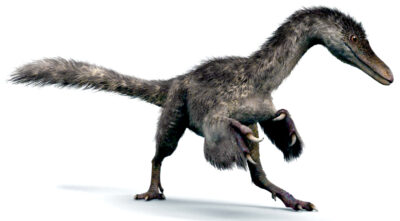 Paleontologist Pascal Godefroit of the Royal Belgian Institute of Natural Sciences in Belgium published a paper in Nature in January, challenging the current understanding of “the first bird.” In Liaoning Province of north-east China, Godefroit collaborated with a research team from the Jilin University Geological Museum, China, and found fossil evidence challenging the Archaeopteryx as “the first bird.” Archaeopteryx means the “ancient wing.”
Paleontologist Pascal Godefroit of the Royal Belgian Institute of Natural Sciences in Belgium published a paper in Nature in January, challenging the current understanding of “the first bird.” In Liaoning Province of north-east China, Godefroit collaborated with a research team from the Jilin University Geological Museum, China, and found fossil evidence challenging the Archaeopteryx as “the first bird.” Archaeopteryx means the “ancient wing.”
Nature published their paper entitled “Reduced plumage and flight ability of a new Jurassic paravian theropod from China,” Godefroit stated –
“These specimens have challenged the pivotal position of Archaeopteryx in bird phylogeny.”
This new feathered dinosaur has been named Eosinopteryx. Eosin is the Greek term for daybreak or dawn: Eosinopteryx is the “dawn of birds.” Finding this fossil in the Jurassic period challenges widely accepted theories on the origin of flight. The new fossil record findings challenge current evolution paradigms.
Eosinopteryx
ScienceDaily, in the article “New dinosaur fossil challenges bird flight origins theories,” highlights the problem –
“A new feathered dinosaur about 30 cm in length which pre-dates bird-like dinosaurs that birds were long thought to have evolved from.”
Gareth Dyke, a paleontologist at the University of Southampton, UK, and co-author, points out a more pervasive issue –
“Our findings suggest that the origin of flight was much more complex than previously thought.”
In an interview published on BBC News entitled “Eosinopteryx feathered dinosaur offers clues on bird evolution,” Dyke explained further –
“This discovery sheds further doubt on the theory that the famous fossil Archaeopteryx — or ‘first bird’ as it is sometimes referred to — as pivotal in the evolution of modern birds,”
Archaeopteryx
Archaeopteryx plays a crucial role in the history of evolution. With the widespread interest in the 1st edition of The Origin of Species by Charles Darwin in 1859, the discovery of the first Archaeopteryx in 1861 quickly gained notoriety. The fossil, discovered by Christian von Meyer, a German paleontologist, provided crucial supporting evidence for Darwin’s theory, it seemed.
Darwin endorsed von Meyer’s finding, but not until 1866, with the Fourth edition of The Origin of Species. According to Darwin –
“Hardly any recent discovery shows [evolution] more forcibly than this [Archaeopteryx].”
By the 6th edition of The Origin of Species in 1872, Darwin further expanded his endorsement –
“Even the wide interval between birds and reptiles has been shown … to be partially bridged over in the most unexpected manner, on the one hand, by the ostrich and extinct Archeopteryx.”
Since then, the Archaeopteryx emerged as the most famous missing fossils ever discovered to support Darwin’s theory. In the words of evolutionary biologist Alan Feduccia of the University of North Carolina at Chapel Hill–
“[The Archaeopteryx] may well be the most important natural history specimen in existence … Beyond doubt, it is the most widely known and illustrated fossil.”
Xiaotingia
The Eosinopteryx, however, is not the first fossil discovery to challenge Archaeopteryx’s notoriety. In 2011, the journal Nature published the discovery of a chicken-sized dinosaur named Xiaotingia. The report title cut-to-the-chase −
“Archaeopteryx no longer first bird.”
“For ornithologists, Archaeopteryx is an icon,” lamented Jack Dumbacher, Curator of Birds and Mammals at the California Academy of Sciences in San Francisco. In an interview with Danielle Venton in 2011, commenting on the Xiaotingia, Dumbacher noted –
“It’s something that kids know from grade school.”
“It may seem heretical to say that Archaeopteryx isn’t a bird, but this idea has surfaced occasionally since as far back as the 1940s,” said paleontologist Lawrence Witmer of Ohio University in a commentary entitled “Archaeopteryx Knocked From Roost as Original Bird.”
“Perhaps the time has come to finally accept that Archaeopteryx was just another small, feathered, bird-like theropod fluttering around in the Jurassic.”
The Archaeopteryx, Xiaotingia, and now the Eosinopteryx vying as “the first bird” only intensifies Darwin’s dilemma.
Genesis
 Archaeopteryx, Xiaotingia, and now the Eosinopteryx demonstrate that identifying “the first bird” is “much more complex than previously thought.” Even in the search for “the first bird,” none of Darwin’s predicted “slight, successive” transitional links between these exist.
Archaeopteryx, Xiaotingia, and now the Eosinopteryx demonstrate that identifying “the first bird” is “much more complex than previously thought.” Even in the search for “the first bird,” none of Darwin’s predicted “slight, successive” transitional links between these exist.
With the predictive value of Darwin’s theory approaching zero, evolution, as a theory, has yet to be scientifically validated. Evidence from Archaeopteryx, Xiaotingia, and Eosinopteryx, however, is compatible with the Genesis account. As Swedish botanist, physician, and zoologist Carolus Linnaeus’ (1707-1778) explained during the Scientific Revolution –
“All the species recognized by Botanists came forth from the Almighty Creator’s hand, and the number of these is now and always will be exactly the same.”
Refer to the Glossary for the definition of terms and to Understanding Evolution to gain insights into understanding evolution.
2020 Update
WIKIPEDIA (2020), nowhere in the article Archaeopteryx states the genus Archaeopteryx to be “the first bird.”
Evolution 101, of the University of California, Berkeley, nowhere states the genus Archaeopteryx to be “the first bird.”
Smithsonian Institute nowhere states the genus Archaeopteryx to be “the first bird.”
Smithsonian Magazine entitled “An Ode to Archaeopteryx” by Riley Black concluded –
“At this point, how closely Archaeopteryx is related to the first birds is an open question which requires more detailed study.”
“The first bird” implies birds evolved. The physical evidence, therefore, is compatible with the conclusion that evolution never happened.

